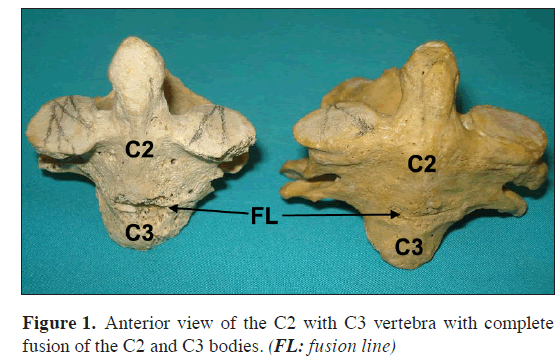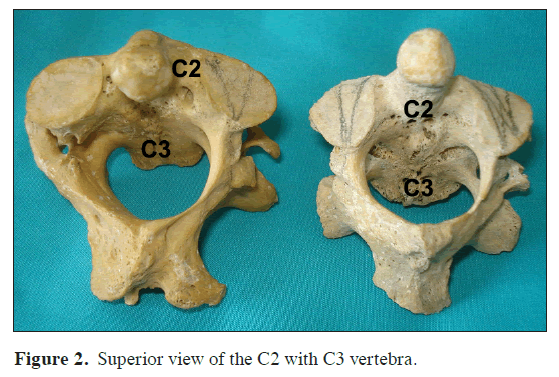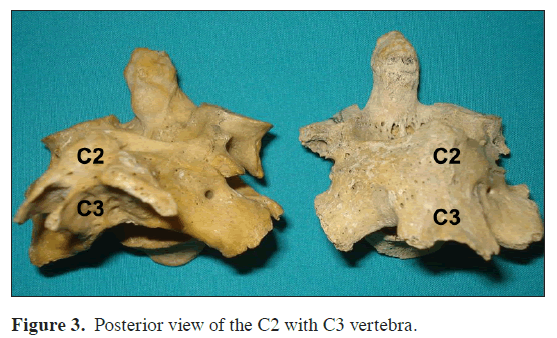Two cases of Klippel-Feil Syndrome
Mehmet Senoglu1*, Davut Ozbag2 and Yakup Gumusalan2
1Kahramanmaras Sutcu Imam University, Faculty of Medicine, Department of Neurosurgery, Kahramanmaras, Turkey
2Department of Anatomy, Kahramanmaras, Turkey
- *Corresponding Author:
- Mehmet Senoglu, MD
Assistant Professor of Neurosurgery, Kahramanmaras Sutcu Imam University, Faculty of Medicine, Department of Neurosurgery 46050 Kahramanmaras, Turkey
Tel: +90 344 2212337
Fax: +90 344 2212371
E-mail: mehmetsenoglu@hotmail.com
Date of Received: June 11th, 2008
Date of Accepted: June 30th, 2008
Published Online: July 10th, 2008
© Int J Anat Var (IJAV). 2008; 1: 6–7.
[ft_below_content] =>Keywords
congenital, fusion, Klippel-Feil Syndrome, cervical, block, vertebrae
Introduction
Klippel-Feil Syndrome (KFS), also known as synostosis of cervical spine, is sporadic, but seldom may be inherited [1,2]. The absence of population screening studies has made it impossible to define the exact incidence and prevalence of KFS. Nevertheless, it has been estimated that it occurs in approximately 1:40,000 to 1:42,000 births [3]. KFS, or synostosis of the cervical spine, occurs as a result of failure in normal segmentation of cervical mesodermal somites during embryonic development. This failure occurs at second-eight weeks of gestation and its cause is unknown [1]. Associated abnormalities may include scoliosis or kyphosis, Sprengel’s deformity, hemivertebrae, platybasia, basilar impression, spina bifida, anomalies of the kidneys and the ribs, cleft palate, respiratory problems, deafness or hearing impairment, and heart malformations [1].
We present two specimens with congenital fusion of C2 with C3. Exhaustive macroscopic observations were performed on the specimens in order to describe the lesions as well as to identify other anomalies.
Case Report
In this report, seventy-five adult human spines were examined. All these spines were of Turkish origin. Each spine was carefully observed for any non-metric variations. We noted two spines showing C2-3 total congenital fusion.
In these specimens, total fusion of the axis vertebra with the C3 was seen (Figures 1, 2, 3). The C2 had fused completely with the C3 in both cases. The intervertebral disc space and posterior elements were fused (Figures 1, 2, 3).
Discussion
In 1912, Maurice Klippel and Andre Feil independently provided the first descriptions of KFS. In 1919, Feil proposed three different types of KFS based on the location and amount of fusion. Later, Clarke and co-authors suggested another classification, where the defects were distinguished by inheritance mechanisms [1,2].
Recently, Samartzis et al. suggested a new classification system. In this system, Type I patients have a single-level fusion; Type II patients have multiple, noncontiguous fused segments; and Type III patients have multiple, contiguous fused segments. Our two spines were Type I according to Samartzis [4].
Studies have suggested that the prevalence of KFS may have a predilection for sex type, with 60% to 70% of KFS cases occurring in females [3-6]. The literature demonstrates that most patients with congenitally fused cervical segments are asymptomatic [4-7].
Axial symptoms of neck/headache, neck pain, and neck stiffness are the predominant symptoms in symptomatic KFS patients and are largely noted in Type I patients who present with a single fused cervical segment [4].
Persistent radicular symptoms or myelopathy are not typical but may require surgical decompression and stabilization [4]. Treatment for KFS is symptomatic and may include surgery to relieve cervical or craniocervical instability and constriction of the spinal cord, and to correct scoliosis. Physical therapy may also be useful [4].
Because of the complex biomechanics of the craniovertebral junction, risk of injury of the upper cervical spine and medullary region is of great concern in the KFS patient. In such patients, the most commonly fused vertebral level is the C2–C3 segment [8,9].
Clinical evidence of the congenitally fused segments is usually not detected until the subluxation is severe enough to cause damage to the spinal cord. As a result, many patients are identified incidentally [9].
The knowledge of Klippel-Feil syndrome may be of importance to neurosurgeons, radiologists, physical therapists, and orthopedic surgeons dealing with the pathologies of cervical spine. Awareness of the presence or absence of such a fusion, as demonstrated on lateral cervical radiographs, may be of value to the neurosurgeon planning the operative and medical approach to the patient.
References
- Fernandes T, Costa C. Klippel-Feil syndrome with other associated anomalies in a medieval Portuguese skeleton (13th-15th century). J. Anat. 2007; 211: 681-685.
- Larson AR, Josephson KD, Pauli RM, Opitz JM, Williams MS. Klippel-Feil anomaly with Sprengel anomaly, omovertebral bone, thumb abnormalities, and flexion-crease changes: novel association or syndrome? Am. J. Med. Genet. 2001; 101: 158-162.
- Thomsen MN, Schneider U, Weber M, Johannisson R, Niethard FU. Scoliosis and congenital anomalies associated with Klippel-Feil syndrome types I-III. Spine. 1997; 22: 396–401.
- Samartzis DD, Herman J, Lubicky JP, Shen FH. Classification of congenitally fused cervical patterns in Klippel-Feil patients: epidemiology and role in the development of cervical spine-related symptoms. Spine. 2006; 31: E798–804.
- Pizzutillo PD, Woods M, Nicholson L, MacEwen GD. Risk factors in Klippel-Feil syndrome. Spine. 1994; 19: 2110–2116.
- Guille JT, Miller A, Bowen JR, Forlin E, Caro PA. The natural history of Klippel-Feil syndrome: clinical, roentgenographic, and magnetic resonance imaging findings at adulthood. J. Pediatr. Orthop. 1995; 15: 617–626.
- Tracy MR, Dormans JP, Kusumi K. Klippel-Feil syndrome: clinical features and current understanding of etiology. Clin. Orthop. Relat. Res. 2004; 424: 183-190.
- Winter RB, Moe JH, Lonstein JE. The incidence of Klippel-Feil syndrome in patients with congenital scoliosis and kyphosis. Spine. 1984; 9: 363–366.
- Shen FH, Samartzis D, Herman J, Lubicky JP. Radiographic assessment of segmental motion at the atlantoaxial junction in the Klippel-Feil patient. Spine. 2006; 31: 171-177.
Mehmet Senoglu1*, Davut Ozbag2 and Yakup Gumusalan2
1Kahramanmaras Sutcu Imam University, Faculty of Medicine, Department of Neurosurgery, Kahramanmaras, Turkey
2Department of Anatomy, Kahramanmaras, Turkey
- *Corresponding Author:
- Mehmet Senoglu, MD
Assistant Professor of Neurosurgery, Kahramanmaras Sutcu Imam University, Faculty of Medicine, Department of Neurosurgery 46050 Kahramanmaras, Turkey
Tel: +90 344 2212337
Fax: +90 344 2212371
E-mail: mehmetsenoglu@hotmail.com
Date of Received: June 11th, 2008
Date of Accepted: June 30th, 2008
Published Online: July 10th, 2008
© Int J Anat Var (IJAV). 2008; 1: 6–7.
Abstract
cervical vertebrae. The true incidence of Klippel-Feil Syndrome is unknown. The most common signs are short neck, low hairline at the back of the head, and restricted mobility of the upper spine. Studies have shown that 34% to 74% of Klippel-Feil Syndrome patients present with such findings. Seventy-five human C2 specimens of both sexes were examined for Klippel-Feil Syndrome. During the osteologic examination for Klippel-Feil Syndrome, we noticed two adult specimens with congenital fusion of C2 and C3 vertebrae.
-Keywords
congenital, fusion, Klippel-Feil Syndrome, cervical, block, vertebrae
Introduction
Klippel-Feil Syndrome (KFS), also known as synostosis of cervical spine, is sporadic, but seldom may be inherited [1,2]. The absence of population screening studies has made it impossible to define the exact incidence and prevalence of KFS. Nevertheless, it has been estimated that it occurs in approximately 1:40,000 to 1:42,000 births [3]. KFS, or synostosis of the cervical spine, occurs as a result of failure in normal segmentation of cervical mesodermal somites during embryonic development. This failure occurs at second-eight weeks of gestation and its cause is unknown [1]. Associated abnormalities may include scoliosis or kyphosis, Sprengel’s deformity, hemivertebrae, platybasia, basilar impression, spina bifida, anomalies of the kidneys and the ribs, cleft palate, respiratory problems, deafness or hearing impairment, and heart malformations [1].
We present two specimens with congenital fusion of C2 with C3. Exhaustive macroscopic observations were performed on the specimens in order to describe the lesions as well as to identify other anomalies.
Case Report
In this report, seventy-five adult human spines were examined. All these spines were of Turkish origin. Each spine was carefully observed for any non-metric variations. We noted two spines showing C2-3 total congenital fusion.
In these specimens, total fusion of the axis vertebra with the C3 was seen (Figures 1, 2, 3). The C2 had fused completely with the C3 in both cases. The intervertebral disc space and posterior elements were fused (Figures 1, 2, 3).
Discussion
In 1912, Maurice Klippel and Andre Feil independently provided the first descriptions of KFS. In 1919, Feil proposed three different types of KFS based on the location and amount of fusion. Later, Clarke and co-authors suggested another classification, where the defects were distinguished by inheritance mechanisms [1,2].
Recently, Samartzis et al. suggested a new classification system. In this system, Type I patients have a single-level fusion; Type II patients have multiple, noncontiguous fused segments; and Type III patients have multiple, contiguous fused segments. Our two spines were Type I according to Samartzis [4].
Studies have suggested that the prevalence of KFS may have a predilection for sex type, with 60% to 70% of KFS cases occurring in females [3-6]. The literature demonstrates that most patients with congenitally fused cervical segments are asymptomatic [4-7].
Axial symptoms of neck/headache, neck pain, and neck stiffness are the predominant symptoms in symptomatic KFS patients and are largely noted in Type I patients who present with a single fused cervical segment [4].
Persistent radicular symptoms or myelopathy are not typical but may require surgical decompression and stabilization [4]. Treatment for KFS is symptomatic and may include surgery to relieve cervical or craniocervical instability and constriction of the spinal cord, and to correct scoliosis. Physical therapy may also be useful [4].
Because of the complex biomechanics of the craniovertebral junction, risk of injury of the upper cervical spine and medullary region is of great concern in the KFS patient. In such patients, the most commonly fused vertebral level is the C2–C3 segment [8,9].
Clinical evidence of the congenitally fused segments is usually not detected until the subluxation is severe enough to cause damage to the spinal cord. As a result, many patients are identified incidentally [9].
The knowledge of Klippel-Feil syndrome may be of importance to neurosurgeons, radiologists, physical therapists, and orthopedic surgeons dealing with the pathologies of cervical spine. Awareness of the presence or absence of such a fusion, as demonstrated on lateral cervical radiographs, may be of value to the neurosurgeon planning the operative and medical approach to the patient.
References
- Fernandes T, Costa C. Klippel-Feil syndrome with other associated anomalies in a medieval Portuguese skeleton (13th-15th century). J. Anat. 2007; 211: 681-685.
- Larson AR, Josephson KD, Pauli RM, Opitz JM, Williams MS. Klippel-Feil anomaly with Sprengel anomaly, omovertebral bone, thumb abnormalities, and flexion-crease changes: novel association or syndrome? Am. J. Med. Genet. 2001; 101: 158-162.
- Thomsen MN, Schneider U, Weber M, Johannisson R, Niethard FU. Scoliosis and congenital anomalies associated with Klippel-Feil syndrome types I-III. Spine. 1997; 22: 396–401.
- Samartzis DD, Herman J, Lubicky JP, Shen FH. Classification of congenitally fused cervical patterns in Klippel-Feil patients: epidemiology and role in the development of cervical spine-related symptoms. Spine. 2006; 31: E798–804.
- Pizzutillo PD, Woods M, Nicholson L, MacEwen GD. Risk factors in Klippel-Feil syndrome. Spine. 1994; 19: 2110–2116.
- Guille JT, Miller A, Bowen JR, Forlin E, Caro PA. The natural history of Klippel-Feil syndrome: clinical, roentgenographic, and magnetic resonance imaging findings at adulthood. J. Pediatr. Orthop. 1995; 15: 617–626.
- Tracy MR, Dormans JP, Kusumi K. Klippel-Feil syndrome: clinical features and current understanding of etiology. Clin. Orthop. Relat. Res. 2004; 424: 183-190.
- Winter RB, Moe JH, Lonstein JE. The incidence of Klippel-Feil syndrome in patients with congenital scoliosis and kyphosis. Spine. 1984; 9: 363–366.
- Shen FH, Samartzis D, Herman J, Lubicky JP. Radiographic assessment of segmental motion at the atlantoaxial junction in the Klippel-Feil patient. Spine. 2006; 31: 171-177.









